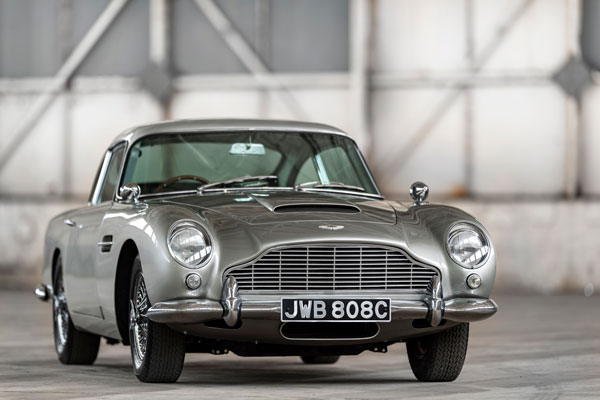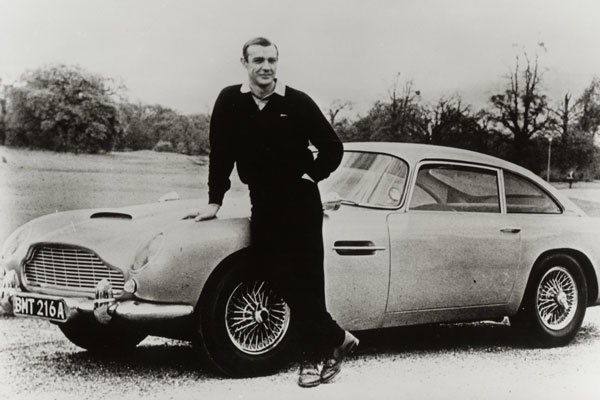Double-0 Heaven: The Aston Martin DB5
This month sees the release in Australia of the latest James Bond cinematic epic, No Time To Die.
No doubt it will be full of action and intrigue, and it will likely do decent business here in Australia, just as it has in the countries in which it has already been released.
As with all Bond movies, there are plenty of big-name stars in the film, but one of the biggest names – and a name that has been associated with the Bond series since the third film, Goldfinger, in 1964 – doesn’t belong to a human actor at all.
And that name would, of course, be Martin . . . Aston Martin.
For many people, Aston Martin is inextricably linked with James Bond. But while the suave British spy may be fictitious, the cars most certainly are not, and in the 59 years since the Bond series began (and there have been 27 movies in that time) a number of fantastic cars from the British luxury carmaker’s stable have featured prominently in a handful of the movies.
There was the magnificent DBS driven by the Aussie 007 George Lazenby in On Her Majesty’s Secret Service (1969), while Timothy Dalton gave the V8 Vantage Volante a go in The Living Daylights (1987). Pierce Brosnan got to dart about in the V12 Vanquish in Die Another Day (2002), while Daniel Craig has been spoiled rotten getting to drive the DBS V12 in Casino Royale (2006) and Quantum of Solace (2008), as well as the DB10 in Spectre (2015).
Aston Martin will play quite a role in No Time To Die as well, with four of the company’s cars apparently making an appearance, including the 1987 Vantage, the new DBS, and the company’s sparkling new toy, the hybrid Valhalla supercar.
Also to grace the screen – and it has been front and centre in the film’s trailer – is the DB5, the most iconic of all James Bond cars.
It has popped up in quite a few of the 007 movies over the years – having first appeared in Goldfinger in 1964 – and, let’s be honest, it is a pleasure to see the car, resplendent in its silver-birch paint job, whenever it roars into shot on screen.
There’s little doubt the DB5’s association with the Bond films has made it a pop-culture icon, but what is going on under that beautiful body? If we forget about all the made-for-the-movies gizmos and gadgetry such as hidden machine guns, ejector seats, rotating number plates, what car do we have here?
To find out, we have to go back to the early 1960s and Aston Martin’s decision to replace the excellent DB4, which it had started producing in 1958.
The company clearly liked the exterior of the DB4, (the DB designation, by the way, is a reference David Brown, the owner of Aston Martin at the time) and the DB5 – a two-door Grand Tourer with a 2+2 seating configuration and a front engine, rear-wheel drive set-up – resembles its predecessor very closely indeed.
The new car had essentially the same body as the DB4 – a body that had been designed by famed Italian coachbuilding firm Carrozzeria Touring Superleggera – and was constructed of aluminium panels over a steel frame body.
It was under the skin that the differences between the two models was most apparent. While both the DB4 and DB5 had a DOHC straight six engine, the DB5’s had been beefed up from a 3.7-litre to a 4-litre unit by increasing the bore to 96mm, and modifications included new valve covers, exhaust manifolds, a bigger air filter, a Lucas alternator to help run the more sophisticated electrical system and three SU carburettors.
The DB5 was also available with a full synchromesh ZF five-speed gearbox or a three-speed Borg-Warner automatic set-up. Suspension included double wishbones at the front with telescopic shock absorbers and a live rear axle and double acting lever arm shock absorbers at the rear. There also were Girling Twin servo assisted brakes with front and rear solid discs, and 15-inch chrome wire wheels.
The upgraded engine gave the DB5 some decent performance figures. Power came in at 210kW and 0-60mph (96.5km/h) was completed in 7.1 seconds with top speed a very tidy 142mph (228.5km/h).
On the inside, luxury was the name of the game. Leather was everywhere, as were wool pile carpets, and there were reclining seats, a seven-gauge dash, electric windows, tinted glass, and a beautiful wood-trim three-spoke steering wheel.
The base model – if we can use such a word for the DB5 – was joined by a high-performance Vantage, introduced in 1965 and which got a number of improvements, including an upgraded 234kW engine and camshafts, and triple-Weber carburettors. Also available was a convertible (which picked up the ‘Volante’ name in 1965), and a ‘shooting brake’ (station wagon to you and me) version.
The DB5 had some serious competition during its production years of 1963-1965. Grand Tourers of the time – in two-seat and 2+2 configurations – included the wonderful Jaguar E-Type and the Maserati 3500 GTi, while Ferrari had the 250 GT Lusso (and more in the pipeline), and even Lamborghini showed up in 1964 with its first production car – the 3.5-litre, V12-powered 350 GT. All these, and others too, were terrific cars, but there’s something about the DB5 that seems to make it just that little bit extra special.
Just over 1000 DB5s were made. Around 900 of these were the coupes – of which 80 were Vantage versions – and another 120 or so were convertibles. Just 12 ‘shooting brake’ models were built. Little wonder that with the DB5 being so rare – and those that are available much sought after by collectors – you’d be hard pressed today to buy one unless you had a cool $1 million or more lying around.
Having said that, they were never cheap. The original 1963 sale price was £4,175, which sounds like a bargain until you realise that the average house price in England that year was around £3,000!
The DB5 was replaced by the DB6 in 1965, but it found everlasting fame through its association with James Bond and in 2018, Aston Martin announced it would produce 25 ‘continuation’ DB5s – faithful versions of the original Goldfinger model, complete with spy gadgets. The cost? Reportedly around the $5 million mark.
So, owning a DB5 – of any era – is out of range for all but the truly wealthy. That’s not really a surprise for a car built in limited numbers, is beautiful to look at, and is an icon of both the automotive world and of pop culture in general.
However, it is easy enough to imagine, when watching Bond at the wheel and cruising the streets of Monte Carlo and the French Riviera, that the feeling of driving one would be very special indeed.
Special enough, perhaps, to leave you both shaken and stirred.
Source: Motor Trader e-Magazine (November 2021)
15 November 2021












